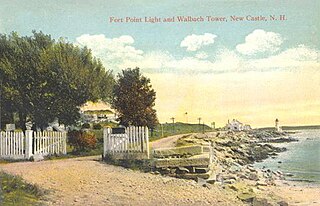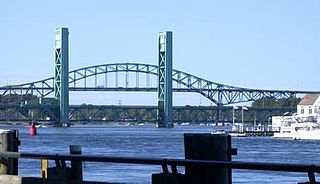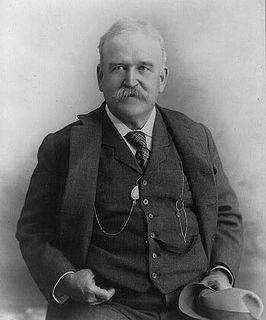
Portsmouth is a city in Rockingham County, New Hampshire, United States. As of the 2010 census it had a population of 21,233, and in 2017 the estimated population was 21,796. A historic seaport and popular summer tourist destination on the Piscataqua River bordering the state of Maine, Portsmouth was formerly the home of the Strategic Air Command's Pease Air Force Base, since converted to Portsmouth International Airport at Pease.

New Castle is a town in Rockingham County, New Hampshire, United States. The population was 968 at the 2010 census. It is the smallest and easternmost town in New Hampshire, and the only one located entirely on islands. It is home to Fort Constitution Historic Site, Fort Stark Historic Site, and the New Castle Common, a 31-acre (13 ha) recreation area on the Atlantic Ocean. New Castle is also home to a United States Coast Guard station, as well as the historic Wentworth by the Sea hotel.

The Norfolk Naval Shipyard, often called the Norfolk Navy Yard and abbreviated as NNSY, is a U.S. Navy facility in Portsmouth, Virginia, for building, remodeling, and repairing the Navy's ships. It is the oldest and largest industrial facility that belongs to the U.S. Navy as well as the most multifaceted. Located on the Elizabeth River, the yard is just a short distance upriver from its mouth at Hampton Roads.

USS New Hampshire (SSN-778), a Virginia-class nuclear-powered attack submarine, is the fourth vessel of the United States Navy to be named for the state of New Hampshire. She is the first of the Virginia Block II submarines to enter service. Her name was awarded to the submarine after a letter-writing campaign by the third-graders from Garrison Elementary School in Dover to their members of Congress, the state governor, and the Secretary of the Navy.

The Seacoast Region is the southeast area of the U.S. state of New Hampshire that includes the eastern portion of Rockingham County and the southern portion of Strafford County. The region stretches 13 miles (21 km) along the Atlantic Ocean from New Hampshire's border with Salisbury, Massachusetts, to the Piscataqua River and New Hampshire's border with Kittery, Maine. The shoreline alternates between rocky and rough headlands and areas with sandy beaches. Some of the beaches are bordered by jetties or groins, particularly in the towns of Rye and Hampton. The Seacoast Region stretches as far west as Epping.

USS Raleigh was one of thirteen ships that the Continental Congress authorized for the Continental Navy in 1775. Following her capture in 1778, she served in the Royal Navy as HBMS Raleigh.

The second USS Portsmouth was a wooden sloop-of-war in the United States Navy in service during the mid-to-late 19th century. She was designed by Josiah Barker on the lines of a French-built privateer, and built at the Portsmouth Navy Yard, directly across the Piscataqua River from Portsmouth, New Hampshire. She was described as an improvement over the USS Saratoga built in the same shipyard a year earlier. The Portsmouth was launched on 23 October 1843 and commissioned on 10 November 1844, with Commander John Berrien Montgomery in command.

A gundalow is a type of flat-bottom cargo vessel once common in Maine and New Hampshire rivers. They first appeared in the mid-1600s, reached maturity of design in the 1700 and 1800s, and lingered into the early 1900s before vanishing as commercial watercraft. Up to 70 feet (21.34 m) long, they characteristically employed tidal currents for propulsion, with a single huge lateen sail brailed to a heavy yard to harness favorable winds.

The Portsmouth Athenæum is an independent membership library, gallery and museum in Portsmouth, New Hampshire, United States. It preserves material relevant to local history, and sponsors exhibitions, concerts and lectures for its proprietors, scholars and the general public. The building has been listed as the "Portsmouth Athenaeum" on the National Register of Historic Places since 1973.

Badger's Island is located in the Piscataqua River at Kittery, Maine, directly opposite Portsmouth, New Hampshire. It carries U.S. Route 1 between the states, connecting to the Kittery mainland by the Badger's Island Bridge, and to New Hampshire by the Memorial Bridge. Now largely a suburb of Portsmouth, the island features houses, condominiums, restaurants and marinas.

William Badger was a master shipbuilder operating in Kittery, Maine, United States who built more than 100 vessels.
The Harbor Defenses of Portsmouth was a United States Army Coast Artillery Corps harbor defense command. It coordinated the coast defenses of Portsmouth, New Hampshire and the nearby Portsmouth Naval Shipyard in Kittery, Maine from 1900 to 1950, both on the Piscataqua River, beginning with the Endicott program. These included both coast artillery forts and underwater minefields. The command originated circa 1900 as the Portsmouth Artillery District, was renamed Coast Defenses of Portsmouth in 1913, and again renamed Harbor Defenses of Portsmouth in 1925.
Peirce Island is a historic 27-acre (11 ha) island owned by the city of Portsmouth, New Hampshire, and is connected to adjacent outlying Four Tree Island. It is connected to the mainland by the Peirce Island bridge. The islands are open to the public and have views of salt marsh, tidal pools, rocky cliffs, and meadows as well as the Portsmouth Naval Shipyard, the South End, three bridges over the Piscataqua River, the "back channel", and a small island toward New Castle, New Hampshire. There is also an outdoor pool, walking paths, playgrounds, and boat launch area.




























